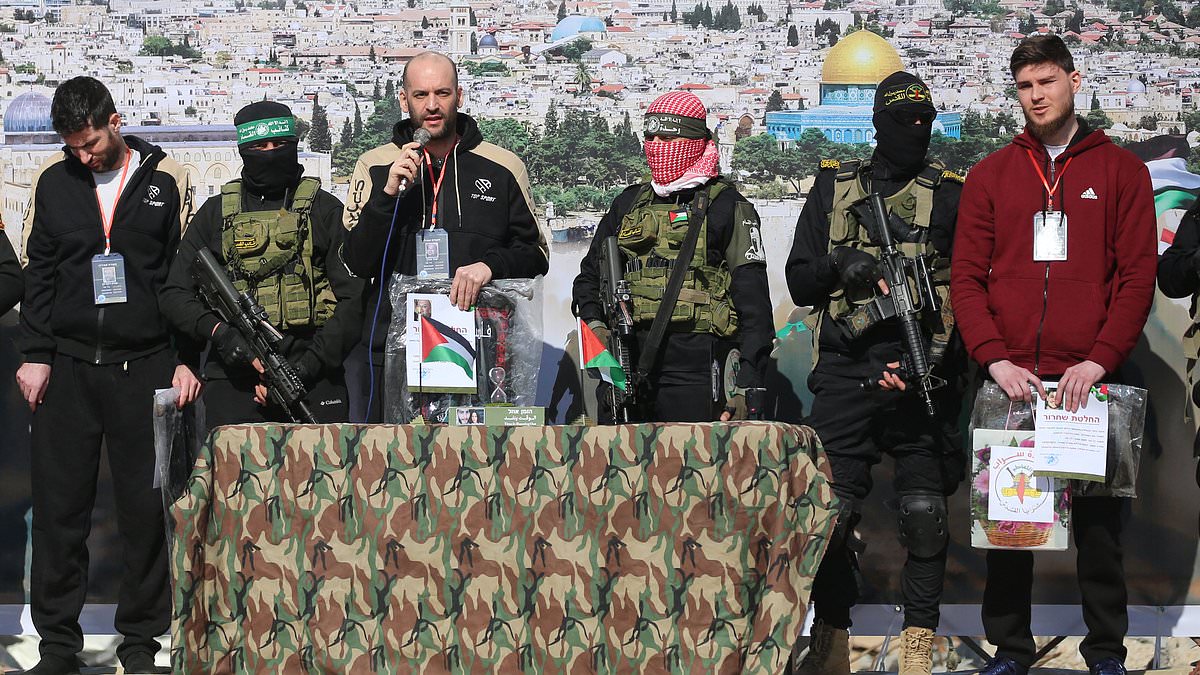Three more Israeli hostages have been released by Hamas terrorists in exchange for 369 Palestinian prisoners, amid concerns the ceasefire would collapse before the sixth such exchange could take place.
US President Donald Trump had warned earlier this week that ‘hell’ would break loose if Hamas failed to release ‘all’ remaining hostages by noon on Saturday.
Israel and Hamas have each accused the other of violating the January 19 ceasefire, with the Palestinian group saying it would pause releases in response – and Israel threatening the resumption of war in the Gaza Strip.
But on Friday both sides signalled the hostage release scheduled for Saturday would go ahead.
Israeli-American Sagui Dekel-Chen, Israeli-Russian Sasha Troufanov, 29, and Israeli-Argentinian Yair Horn, 46, were named as the hostages being released today, the office of Israeli Prime Minister Benjamin Netanyahu said.
Dekel-Chen, 36, is set to meet his third daughter for the first time, after the youngster – now over a year old – was born while he was still held hostage.
On Saturday morning, dozens of Hamas fighters lined up in the main southern city of Khan Yunis around a stage bearing the logo of the group’s armed wing, the Ezzedine Al-Qassam Brigades.
Sources from Hamas and Islamic Jihad said the groups had deployed about 200 militants for the handover ceremony.
They have been held by Gaza terrorists since Hamas’s October 7, 2023 attack on Israel that sparked the war.
The Palestinian Prisoners’ Club advocacy group said Israel was to release 369 inmates in exchange, with 24 of them expected to be deported.
The vast majority, 333 people, are ‘prisoners from the Gaza Strip who were arrested after October 7’, the group said.
After the crisis that appeared to bring the truce to a breaking point, Hamas said on Friday it expected talks on a second phase of the ceasefire to begin early next week.
United States Secretary of State Marco Rubio, whose country is Israel’s top backer and one of the truce mediators, is due to arrive in Israel late Saturday ahead of expected talks with Netanyahu on the Gaza truce.
Last week’s release sparked anger in Israel and beyond after the freed hostages were paraded onstage, with their emaciated state sparking concern over conditions in captivity.
Israeli-American hostage Keith Siegel, who was released in a previous exchange, said he was ‘starved and… tortured, both physically and emotionally’ during his captivity.
There were also fears for Palestinians in Israeli custody after some prisoners required medical treatment after their release in the last swap.
The ceasefire has been under massive strain since US President Donald Trump proposed a takeover of the Gaza Strip under which the territory’s population of more than two million people would be moved to Egypt or Jordan.
For Palestinians, any forced displacement evokes memories of the ‘Nakba’, or catastrophe – the mass displacement of their ancestors during Israel’s creation in 1948.
The stage set up for the hostage release on Saturday bore an illustrated poster appearing to depict the final moments of Hamas’s former leader Yahya Sinwar, who was killed by Israeli forces in October.
The poster showed the Al-Aqsa Mosque visible through a hole in the wall of a destroyed building along with the slogan: ‘No displacement except to Jerusalem’.
Arab countries have also come together to reject the plan, and Saudi Arabia will host the leaders of Egypt, Jordan, Qatar and the United Arab Emirates on Thursday for a summit on the issue.
After the Riyadh summit, the Arab League will convene in Cairo on February 27 to discuss the same issue.
Following Trump’s warning this week that ‘hell’ would break loose if Hamas failed to release ‘all’ remaining hostages by noon on Saturday, Israel insisted Hamas release ‘three living hostages’ or ‘the ceasefire will end’.
If fighting resumes, Defence Minister Israel Katz said it would not just lead to the ‘defeat of Hamas and the release of all the hostages’ – Israel’s stated objectives since the start of the war – but also ‘allow the realisation of US President Trump’s vision for Gaza’.
Under the terms of the 42-day first phase of the ceasefire agreement brokered by Qatar, Egypt and the United States, negotiations for a second phase were due to start on February 3.
Netanyahu had sent negotiators to Doha days later, but the delegation was not mandated to discuss phase two, which is meant to lay out steps towards ending the war.
Hamas official Taher al-Nunu said on Friday that ‘we expect the second phase of the ceasefire negotiations to begin early next week’.
Another source familiar with the talks told AFP that ‘mediators informed Hamas that they hope to start the second phase of negotiations next week in Doha’.
The October 7, 2023 attack on Israel resulted in the deaths of 1,211 people, mostly civilians, according to an AFP tally of Israeli official figures.
Terrorists also took 251 hostages, of whom 73 remain in Gaza, including 35 the Israeli military says are dead.
Israel’s retaliatory campaign has killed at least 48,239 people in Gaza, the majority of them civilians, according to figures from the health ministry in the Hamas-run territory that the United Nations considers reliable.
